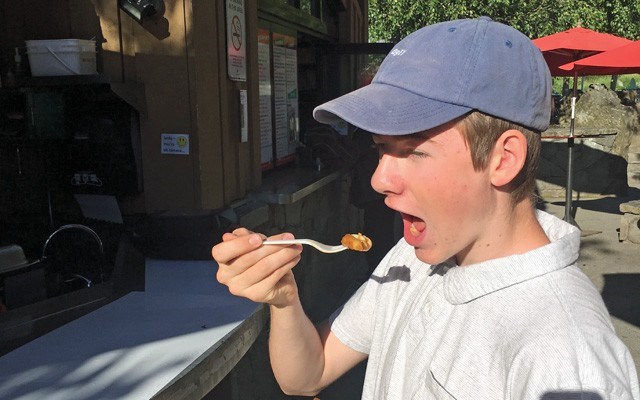This Saturday, picture the intrepidly creative Michele Bush (a.k.a. Bushwoman) diving into a pot of clams fresh from the beach on Savary Island. A divine-smelling pot bubbling with garlic, onions, cream, potatoes and, of course, Canadian bacon.
It will be a feast inspired by one her family stumbled onto years ago near the now-defunct Royal Savary Hotel. She was a kid and the six Bushes had just landed after being stuffed into the family's little sailboat. In front of the hotel on the beach, guests were huddled around a deliciously massive pot of same. Only this Canada Day, it will be Bushwoman simmering local clams for her pals from Chicago, all while teaching them to sing "O Canada." Apparently, it will come out sounding like "O Cyanyada" in a Chicago accent.
Whether it's fresh clams, maple syrup (which some think we drink straight from the tree), Timbits or anything Tim Hortons, koobideh (minced kebob typical in Turkey and Iran), or a giant cake with red and white icing, we all have our little food traditions on Canada Day. Whatever form they take — and they're diverse as the nation itself, what with our deep heritage of newcomers — they're all served up with a big side of fun and plenty of family and friends.
But before we explore other proud dishes that might stand as poster children for Canadian food — after all, we're pretty flexible and accommodating, eh? — given this year's 150th Canada Day is generating all kinds of interesting conversations with our nation's original inhabitants, what I first want to dive into is some of their local traditional foods.
My informed advisor is Alison Pascal-Mixalhíts'a7, member of the Lil'wat Nation and junior curator at the Squamish Lil'wat Cultural Centre in the heart of Whistler. What better place to start any Canada Day celebration!
"One of the great things about living in Sea to Sky corridor is that because we live in the temperate rainforest, there's really a lot of diversity here, so there are really a lot of foods you can eat, starting with all the fresh vegetables," says Alison. (Her classic Canadian pick, BTW, is oven-baked salmon with a maple syrup glaze.)
Wild potatoes and onions, skunk cabbage roots in springtime, various local ferns — even the tender green tips of salmonberry and thimbleberry bushes in spring, which are harvested much as you bend the stalks of fresh asparagus to break off the woody bits. All are part of indigenous diets at Whistler, which traditionally has been shared by the Squamish and Lil'wat nations.
"A very long time ago, the two communities decided this was going to be a shared area instead of continuing to fight over a border," says Alison.
For fruit, Squamish and Lil'wat people gather wild berries — salmonberries, thimbleberries, raspberries and, the big favourite, huckleberries. As well, the area is "very blessed in that we have a lot of different types of fish," she adds.
Different species were key in different seasons. Rainbow and Dolly Varden trout were prime in fall and winter (there were a lot of natural freshwater fish runs from Squamish to Mount Currie before roads and diking systems were introduced), while spring and sockeye salmon were major in summer. Herring were abundant before the Britannia copper mine, and around Squamish people enjoyed all the shellfish from Howe Sound.
As for the "hunting" part of the traditional hunter-gatherer equation, it was everything from big game like moose and deer as well as wildfowl (ducks, geese, grouse) and small mammals. Even the whistling marmot, for which Whistler is named, is an indigenous food source.
With that wee glimpse of traditional foods in this beautiful mountain corridor, here's the latest on all-Canadian dishes. According to Maclean's, that other iconic Canadian newsmagazine with a red maple leaf in its wordmark, a survey of 1,500 people named poutine as the No. 1 "favourite iconic Canadian food," beating maple syrup and lobster. (Must have asked a lot of Eastern Canucks!)
For those who don't know what poutine is, and many don't, you can trace it back to 1950s Quebec. A combo of "squeaky" white cheese curds, gravy and French fries, the dish, like so many Canadians, has migrated steadily west. Toronto and Ottawa now have poutine fests. Even the West Coast has added poutine to our fast-food staples.
Given I've never met a poutine I could get excited about, for a survey or otherwise, I searched around for fans, and came up with two big ones. Kayley and Matthew Ogilvie-Turner — yes, the lovely kids of Pique's fearless editor, Clare — both love poutine. And when I asked where to find Whistler's best, it was definitely Zog's Dogs.
No surprise, for Zog's is king of the poutine scene. Co-owner Sol Stuckey estimates they serve more than 37,000 dishes of poutine a year. They have seven options, including Canadian, with a weiner on top; Euro, with a bratwurst; even a Mexican poutine with a jalapeno and cheese smokie. But it's the classic that Matthew and Kayley go for.
"Their gravy is super good and thick!" says Matthew. "It tastes like gravy you make at home with real roast chicken or roast beef."
"It's a nice ratio of fries to gravy," adds Kayley. "If the ratio is off it's not going to work because you eat all the fries and there's too much gravy, or there's not enough gravy for the fries." That, and the gravy has to be hot enough to melt the cheese so it's nice and stringy.
So what's your super-Canadian food? Whatever your pick, enjoy it on Canada Day!
Glenda Bartosh is an award-winning journalist who has a lot of great Canadian favourites.




